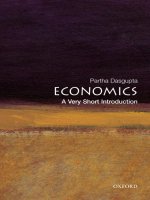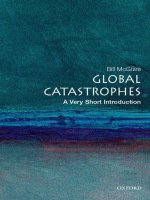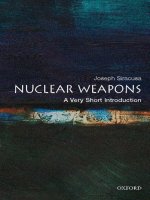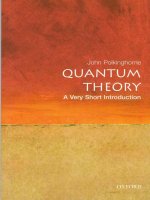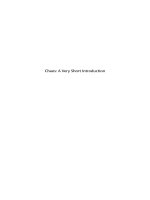modern china a very short introduction
Bạn đang xem bản rút gọn của tài liệu. Xem và tải ngay bản đầy đủ của tài liệu tại đây (1.97 MB, 169 trang )
Modern China: A Very Short Introduction
AFRICAN HISTORY
John Parker and Richard Rathbone
AMERICAN POLITICAL PARTIES
AND ELECTIONS L. Sandy Maisel
THE AMERICAN PRESIDENCY
Charles O. Jones
ANARCHISM Colin Ward
ANCIENT EGYPT Ian Shaw
ANCIENT PHILOSOPHY Julia Annas
ANCIENT WARFARE
Harry Sidebottom
ANGLICANISM Mark Chapman
THE ANGLO-SAXON AGE John Blair
ANIMAL RIGHTS
David DeGrazia
ANTISEMITISM Steven Beller
ARCHAEOLOGY Paul Bahn
ARCHITECTURE Andrew Ballantyne
ARISTOTLE Jonathan Barnes
ART HISTORY Dana Arnold
ART THEORY Cynthia Freeland
THE HISTORY OF STRONOMY
Michael Hoskin
ATHEISM Julian Baggini
AUGUSTINE Henry Chadwick
BARTHES Jonathan Culler
BESTSELLERS John Sutherland
THE BIBLE John Riches
THE BRAIN Michael O’Shea
BRITISH POLITICS Anthony Wright
BUDDHA Michael Carrithers
BUDDHISM Damien Keown
BUDDHIST ETHICS Damien Keown
CAPITALISM James Fulcher
THE CELTS Barry Cunliffe
CHAOS Leonard Smith
CHOICE THEORY Michael Allingham
CHRISTIAN ART Beth Williamson
CHRISTIANITY Linda Woodhead
CLASSICS
Mary Beard and John Henderson
CLASSICAL MYTHOLOGY
Helen Morales
CLAUSEWITZ Michael Howard
THE COLD WAR Robert McMahon
CONSCIOUSNESS Susan Blackmore
CONTEMPORARY ART
Julian Stallabrass
CONTINENTAL PHILOSOPHY
Simon Critchley
COSMOLOGY Peter Coles
THE CRUSADES Christopher Tyerman
CRYPTOGRAPHY
Fred Piper and Sean Murphy
DADA AND SURREALISM
David Hopkins
DARWIN Jonathan Howard
THE DEAD SEA SCROLLS Timothy Lim
DEMOCRACY Bernard Crick
DESCARTES Tom Sorell
DESIGN John Heskett
DINOSAURS David Norman
DOCUMENTARY FILM
Patricia Aufderheide
DREAMING J. Allan Hobson
DRUGS Leslie Iversen
THE EARTH Martin Redfern
ECONOMICS Partha Dasgupta
EGYPTIAN MYTH Geraldine Pinch
VERY SHORT INTRODUCTIONS are for anyone wanting a stimulating
and accessible way in to a new subject. They are written by experts, and have
been published in more than 25 languages worldwide.
The series began in 1995, and now represents a wide variety of topics in
history, philosophy, religion, science, and the humanities. Over the next
few years it will grow to a library of around 200 volumes – a Very Short
Introduction to everything from ancient Egypt and Indian philosophy to
conceptual art and cosmology.
Very Short Introductions available now:
EIGHTEENTH-CENTURY BRITAIN
Paul Langford
THE ELEMENTS Philip Ball
EMOTION Dylan Evans
EMPIRE Stephen Howe
ENGELS Terrell Carver
ETHICS Simon Blackburn
THE EUROPEAN UNION
John Pinder and Simon Usherwood
EVOLUTION
Brian and Deborah Charlesworth
EXISTENTIALISM Thomas Flynn
FASCISM Kevin Passmore
FEMINISM Margaret Walters
THE FIRST WORLD WAR
Michael Howard
FOSSILS Keith Thomson
FOUCAULT Gary Gutting
THE FRENCH REVOLUTION
William Doyle
FREE WILL Thomas Pink
FREUD Anthony Storr
FUNDAMENTALISM Malise Ruthven
GALAXIES John Gribbin
GALILEO Stillman Drake
GAME THEORY Ken Binmore
GANDHI Bhikhu Parekh
GEOPOLITICS Klaus Dodds
GERMAN LITERATURE Nicholas Boyle
GLOBAL CATASTROPHES Bill McGuire
GLOBALIZATION Manfred Steger
GLOBAL WARMING Mark Maslin
THE GREAT DEPRESSION AND
THE NEW DEAL Eric Rauchway
HABERMAS James Gordon Finlayson
HEGEL Peter Singer
HEIDEGGER Michael Inwood
HIEROGLYPHS Penelope Wilson
HINDUISM Kim Knott
HISTORY John H. Arnold
HIV/AIDS Alan Whiteside
HOBBES Richard Tuck
HUMAN EVOLUTION Bernard Wood
HUMAN RIGHTS Andrew Clapham
HUME A. J. Ayer
IDEOLOGY Michael Freeden
INDIAN PHILOSOPHY Sue Hamilton
INTELLIGENCE Ian J. Deary
INTERNATIONAL MIGRATION
Khalid Koser
INTERNATIONAL RELATIONS
Paul Wilkinson
ISLAM Malise Ruthven
JOURNALISM Ian Hargreaves
JUDAISM Norman Solomon
JUNG Anthony Stevens
KABBALAH Joseph Dan
KAFKA Ritchie Robertson
KANT R
oger Scruton
KIERKEGAARD Patrick Gardiner
THE KORAN Michael Cook
LAW Raymond Wacks
LINGUISTICS Peter Matthews
LITERARY THEORY Jonathan Culler
LOCKE John Dunn
LOGIC Graham Priest
MACHIAVELLI Quentin Skinner
THE MARQUIS DE SADE John Phillips
MARX Peter Singer
MATHEMATICS Timothy Gowers
MEDICAL ETHICS Tony Hope
MEDIEVAL BRITAIN
John Gillingham and Ralph A. Griffiths
MODERN ART David Cottington
MODERN CHINA Rana Mitter
MODERN IRELAND Senia Pašeta
MOLECULES Philip Ball
MUSIC Nicholas Cook
MYTH Robert A. Segal
NATIONALISM Steven Grosby
THE NEW TESTAMENT AS
LITERATURE Kyle Keefer
NEWTON Robert Iliffe
NIETZSCHE Michael Tanner
NINETEENTH-CENTURY BRITAIN
Christopher Harvie and
H. C. G. Matthew
NORTHERN IRELAND
Marc Mulholland
NUCLEAR WEAPONS
Joseph M. Siracusa
PARTICLE PHYSICS Frank Close
PAUL E. P. Sanders
PHILOSOPHY Edward Craig
PHILOSOPHY OF LAW
Raymond Wacks
PHILOSOPHY OF SCIENCE
Samir Okasha
PHOTOGRAPHY Steve Edwards
PLATO Julia Annas
POLITICS Kenneth Minogue
POLITICAL PHILOSOPHY
David Miller
POSTCOLONIALISM Robert Young
POSTMODERNISM Christopher Butler
POSTSTRUCTURALISM
Catherine Belsey
PREHISTORY Chris Gosden
PRESOCRATIC PHILOSOPHY
Catherine Osborne
PSYCHOLOGY
Gillian Butler and Freda McManus
PSYCHIATRY Tom Burns
THE QUAKERS Pink Dandelion
QUANTUM THEORY
John Polkinghorne
RACISM Ali Rattansi
THE RENAISSANCE Jerry Brotton
RENAISSANCE ART
Geraldine A. Johnson
ROMAN BRITAIN Peter Salway
THE ROMAN EMPIRE
Christopher Kelly
ROUSSEAU Robert Wokler
RUSSELL A. C. Grayling
RUSSIAN LITERATURE Catriona Kelly
THE RUSSIAN REVOLUTION
S. A. Smith
SCHIZOPHRENIA
Chris Frith and Eve Johnstone
SCHOPENHAUER Christopher Janaway
SHAKESPEARE Germaine Greer
SIKHISM Eleanor Nesbitt
SOCIAL AND CULTURAL
ANTHROPOLOGY
John Monaghan and Peter Just
SOCIALISM Michael Newman
SOCIOLOGY Steve Bruce
SOCRATES C. C. W. Taylor
THE SPANISH CIVIL WAR
Helen Graham
SPINOZA Roger Scruton
STUART BRITAIN John Morrill
TERRORISM Charles Townshend
THEOLOGY David F. Ford
THE HISTORY OF TIME
Leofranc Holford-Strevens
TRAGEDY Adrian Poole
THE TUDORS John Guy
TWENTIETH-CENTURY BRITAIN
Kenneth O. Morgan
THE VIKINGS Julian Richards
WITTGENSTEIN A. C. Grayling
WORLD MUSIC Philip Bohlman
THE WORLD TRADE
ORGANIZATION Amrita Narlikar
Available soon:
For more information visit our website
www.oup.co.uk/general/vsi/
1066 George Garnett
EXPRESSIONISM
Katerina Reed-Tsocha
GEOGRAPHY
John Matthews and David Herbert
HISTORY OF MEDICINE
William Bynum
MEMORY Jonathan Foster
NELSON MANDELA Elleke Boehmer
SCIENCE AND RELIGION
Thomas Dixon
SEXUALITY Véronique Mottier
THE MEANING OF LIFE
Terry Eagleton
Rana Mitter
Modern
China
A Very Short Introduction
1
1
Great Clarendon Street, Oxford OX2 6DP
Oxford University Press is a department of the University of Oxford.
It furthers the University’s objective of excellence in research, scholarship,
and education by publishing worldwide in
Oxford New York
Auckland Cape Town Dar es Salaam Hong Kong Karachi
Kuala Lumpur Madrid Melbourne Mexico City Nairobi
New Delhi Shanghai Taipei Toronto
With offi ces in
Argentina Austria Brazil Chile Czech Republic France Greece
Guatemala Hungary Italy Japan Poland Portugal Singapore
South Korea Switzerland Thailand Turkey Ukraine Vietnam
Oxford is a registered trade mark of Oxford University Press
in the UK and in certain other countries
Published in the United States
by Oxford University Press Inc., New York
© Rana Mitter 2008
The moral rights of the author have been asserted
Database right Oxford University Press (maker)
First published 2008
All rights reserved. No part of this publication may be reproduced,
stored in a retrieval system, or transmitted, in any form or by any means,
without the prior permission in writing of Oxford University Press,
or as expressly permitted by law, or under terms agreed with the appropriate
reprographics rights organization. Enquiries concerning reproduction
outside the scope of the above should be sent to the Rights Department,
Oxford University Press, at the address above
You must not circulate this book in any other binding or cover
and you must impose the same condition on any acquirer
British Library Cataloguing in Publication Data
Data available
Library of Congress Cataloging in Publication Data
Data available
ISBN 978–0–19–922802–7
1 3 5 7 9 10 8 6 4 2
Typeset by SPI Publisher Services, Pondicherry, India
Printed in Great Britain by
Ashford Colour Press Ltd, Gosport, Hampshire
Contents
Acknowledgements ix
Pronunciation xi
List of illustrations xiii
1
What is modern China? 1
2
The old order and the new 17
3
Making China modern 40
4
Is Chinese society modern? 74
5
Is China’s economy modern? 102
6
Is Chinese culture modern? 118
7
Brave new China? 139
Timeline 141
References 143
Further reading 146
Index 149
This page intentionally left blank
Acknowledgements
I am very grateful to all those at Oxford University Press who
commissioned this Very Short Introduction and saw it through its
various stages of life: Marsha Filion, Luciana O’Flaherty, Deborah
Protheroe, and James Thompson. Writing this book made copious
reading necessary. I could not have easily made the time to do
that reading and refl ection without teaching relief funded by the
generous grant of a Philip Leverhulme Prize by the Leverhulme
Trust, for which I am immensely grateful. On-the-ground
observations in 2006 were made possible by the kind award
of a place on the British Academy–Chinese Academy of Social
Sciences exchange scheme. I also owe thanks to the anonymous
reviewers who gave valuable comments both at proposal and
manuscript stage. Colleagues and friends contributed in many
ways to the book, but I must single out Graham Hutchings and
Neil Pyper, who patiently read and commented on the whole of a
very rough draft with wit and copious good sense. I have also had
the constant support of my parents and Pamina. Katharine read
and commented on the entire manuscript, and offered support in
countless other ways. This book is dedicated to her.
This page intentionally left blank
Pronunciation
This book uses the pinyin system of romanization of Chinese.
Very approximately indeed, the transliterations that cause most
problems for English-speakers are the following sounds:
c – pronounced ‘ts’
x – pronounced ‘sh’
q – pronounced ‘ch’
And the sounds chi, zhi, ri, si, shi, and zi are pronounced as if the
‘i’ sound is an ‘rr’ – so ‘chr’, ‘zhr’, and so forth.
This page intentionally left blank
List of illustrations
1 Workers waiting to end
a long day
3
© Gideon Mendel/Corbis
2 Wealthy Chinese woman with
bound feet
9
© Underwood & Underwood/Corbis
3 Famine victims in China 28
© Hulton Archive/Getty Images
4 British armoured car in
Shanghai, c. 1935
33
© Hulton Archive/Getty Images
5 General Chiang Kaishek,
c. 1930
38
© Hulton Archive/Getty Images
6 Chinese refugees, Chongqing,
c. 1937
47
© Hulton Archive/Getty Images
7 Mao Zedong on the Long
March, c. 1935
49
© Hulton Archive/Getty Images
8 Mao Zedong 51
© Hulton Archive/Getty
Images
9 Guard aiming a rifl e at
a Chinese landlord
farmer
57
© Bettmann/Corbis
10 Chairman Mao with young
students
59
© Bettmann/Corbis
11 Performance during the
Cultural Revolution
61
© Bettmann/Corbis
12 Tourists take photos,
Shenzhen
66
© National Geographic/Getty
Images
13 Chinese students asking for
democracy
68
© Peter Turnley/Corbis
The publisher and the author apologize for any errors or omissions in the
above list. If contacted they will be pleased to rectify these at the earliest
opportunity.
14 Chinese woman’s feet distorted
by foot-binding
76
© Bettmann/Corbis
15 Men pulling a plough 86
© Christopher Boisvieux/Corbis
16 Olympic Five Rings 95
© China Photos/Getty Images
17 Urban woman protecting
herself from smog
115
© Wally McNamee/Corbis
18 Section of ‘Nine Horses’
scroll by Ren Renfa, from
Master Gu’s Pictorial Album
(1603)
120
© Percival David Foundation of
Chinese Art
19 SuperGirl fi nals 133
© AP/PA Photos/Empics
20 Pudong skyline 137
© Xiaoyang Liu/Corbis
1
Chapter 1
What is modern China?
It is impossible to do other than assent to the unanimous verdict
that China has at length come to the hour of her destiny … The
contempt for foreigners is a thing of the past … Even in remote
places we have found the new spirit – its evidence, strangely
enough, the almost universal desire to learn English … as
knowledge of English is held to be the way to advancement, the key
to a knowledge of the science and art, the philosophy and policy, of
the West.
This assessment comes from the book New China by W. Y.
Fullerton and C. E. Wilson. In the third decade of China’s era
of ‘reform and opening-up’ (kaifang gaige), at last the clichés
of the old Maoist era – the Chinese as worker ants mouthing
xenophobic anti-imperialist slogans while all dressed in blue
serge boiler-suits – have given way to impressions of a country
whose cities are full of skyscrapers, whose rural areas are being
transformed by new forms of land ownership and a massive rise
in migrant labour, and whose population is keen to engage with
the outside world after years of isolation. Fullerton and Wilson’s
observation that China is reaching the ‘hour of her destiny’, and
that a signifi cant part of the population are learning English as
one way to fulfi l that destiny, seems a reasonable comment on a
China that is clearly very different from the one ruled a generation
ago by Chairman Mao.
2
Modern China
However, Fullerton and Wilson did not pen their observations
having landed back at Kennedy or Heathrow airports on one
of the many Air China 747s that ferry thousands of travellers
daily between China and the West. They wrote their book a full
century ago, and their refl ections on what they subtitle ‘a story
of modern travel’ came at what, in retrospect, is a particularly
poignant moment in China’s history: the year 1910. The China
they portray was lively, even optimistic, and very much engaged
with the outside world. Yet within a year, the Qing dynasty,
the last Chinese imperial house which still ruled the country
that Fullerton and Wilson saw, had fallen. The revolution of
October 1911 fi nally brought the two-thousand-year tradition
of imperial rule in China to an end, making way for a Republic.
That Republic would collapse less than 40 years later, and
would be succeeded in turn by a People’s Republic whose own
form would change over decades as it struggled to defi ne what
‘modern’ China was. It is a sign of how long it has taken for
China to defi ne its own vision of modernization that a travel
description from the early 20th century can still have resonance
in the early 21st.
China is the world’s most populous country, with some 1.3 billion
inhabitants at the beginning of the 21st century. Its economy grew
in the fi rst decade of this century by an average of around 10% a
year. It is seeking a regional and global role, with a new political
and economic presence in Africa, Latin America, and the Middle
East, and has taken frequent steps to portray itself as a responsible
member of the world community, playing a role in troublesome
areas such as Iran and North Korea where the West has little
sway. The 2008 Beijing Olympics mark the ‘coming-out’ of China
as an integrated member of the world community of nations, the
acme of the ‘peaceful rise’ which it has been engineering since the
mid-1990s. The term ‘peaceful rise’ (heping jueqi) itself, associated
with the political thinker Zheng Bijian, was thought by Chinese
ideologists to be too confrontational, and has been replaced with
the term ‘peaceful development’. The idea remains the same,
3
What is modern China?
however: that China is fi nally gaining the role as a regional and
global power that it lost in the mid-19th century.
Everywhere one goes in China, there are signs of change.
Signifi cant areas of western China have been fl ooded to make way
for the massive Three Gorges Dam on the Yangtze River. Their
former inhabitants are being relocated and urbanized as China
moves away from its traditional agricultural past. In the cities,
Baidu, a home-grown Chinese internet search engine, dominates
the market which is held by the worldwide brand leader, Google,
in most other countries. Beneath China’s strict censorship laws
lies a ‘grey zone’ of cultural production: from underground movies
criticizing the Cultural Revolution to pornography, cultural rebels
fi nd ways to make their views known.
China is now a major actor in world markets. Through much of
the early 2000s, China’s burgeoning exports led to concerns in
1. Illegal migrant labourers are a common sight on Chinese building
sites. Their work underpins the futuristic skylines in cities such as
Shanghai and Beijing
4
Modern China
the US and EU about the Chinese trade surplus. The West was
also concerned about the strength of the Chinese currency (the
yuan or renminbi) against the dollar, with the Americans and
French frequently lobbying the People’s Bank of China to revalue
it upwards. The Chinese current account surplus also means that
it has had cash to spend on investments around the world, from
the US, to Africa, to Russia. Chinese companies bought the assets
of the bankrupt British Rover car group in 2005; Chinese capital
was offered to help blue-chip UK high street bank Barclays pay for
a takeover of a Dutch rival, ABN-AMRO, in 2007.
Yet China is also undertaking one of the most precarious
balancing acts in world history. While the country has the
fastest-growing major economy in the world, it is also becoming
one of the globe’s most unequal societies, even while its policies lift
millions out of poverty. For the rural and urban poor, health care
and education are available only to those who can pay for them.
China is also in the grip of a resource and environmental crisis.
All across China, power blackouts regularly interrupt industrial
production. Globally, the country must scramble for energy and
mineral resources. Environmental degradation forces bicyclists
to wear smog masks and has rendered the Yangtze dolphin
extinct. As global warming accelerates, China is set to become
the world’s largest emitter of carbon dioxide into the atmosphere.
China continues to maintain a one-party dictatorship and heavily
constrains political dissent; yet every year, there are thousands
of demonstrations against offi cial policies and practice, some of
them violent. Corruption also runs rife.
There are signifi cant differences between China at the start of the
20th century, and the start of the 21st. The China of a century ago
was the victim of Western and Japanese imperialism, in danger,
in the phrase of the time, of ‘being carved up like a melon’ by the
foreign powers. It was a weak and vulnerable state. Today’s China,
while it has deep frictions and fault lines, is a much stronger
entity. Yet the similarities between China now and China a
5
What is modern China?
hundred years ago are startling also: political instability, economic
and social crisis, and the need for China to fi nd a role in a world
dominated, even if less so than in the post-Cold War moment, by
the West.
Chinese leaders, who are acutely conscious of history in a way that
has been less true of the American and British governing classes in
recent years, would also note that the seemingly moribund Qing
dynasty had begun to modernize impressively fast in the early
years of the 20th century. Nonetheless, it collapsed, as did most
of its successor regimes in the following four decades. It is the
earnest intention of the rulers of the People’s Republic of China
that this fate should never happen to them. To understand their
fears and concerns, and to understand China in its own terms, the
China of today can only be understood in its historical and global
context. That is what this book tries to do, explaining the reasons
that modern China looks the way that it does.
Overall, the book hopes to give a picture of China that refl ects
three main viewpoints. First, rather than being a closed society,
China has almost always been a society open to outside infl uence,
and ‘Chinese’ culture and society cannot be understood in
isolation from the outside world. In other words, China cannot
be treated as a special case of an isolated society, but rather as
part of a changing regional and global culture. Second, it is too
simple to say that China has moved from a ‘traditional’ past to
a ‘modern’ present. Rather, the modern China we see today is a
complex mixture of indigenous social infl uences and customs and
external infl uences, often, but not always, from the West. Society
did not change overnight in 1912 with the abdication of the last
emperor, or in 1949 with the Communist revolution, but neither
is the modern China of today essentially the same as when the
emperors were on the throne a hundred or two hundred years ago.
Third, our understanding of how modern China has developed
should not come only through following elite politics and leaders
and their confl icts. Instead, we should look at continuities as well
6
Modern China
as changes in how the Chinese have come to modernity, and the
impact of change on society and culture as a whole.
What does it mean to be Chinese?
A hundred years ago and today, an important question remains:
What is modern China? To come to an answer, we need to spend a
little time investigating both terms – China and modern.
‘China’ today generally refers to the People’s Republic of China,
the state that was established in 1949 after the victory of the
Chinese Communist Party under the leadership of Chairman
Mao Zedong. That state essentially covers the same territory as
the Chinese empire under the last imperial dynasty, the Qing
(1644–1911), which extended its reach to the west and north of
the lands that earlier dynasties had controlled. (The modern state,
however, has a fi rm grasp on Tibet, does not lay claim to Outer
Mongolia or the lands in the northeast taken by Tsarist Russia,
and in practice does not control Taiwan.) However, this continuity
of geography conceals the reality that China has changed shape
over the centuries, and continues to do so even now. About 2,500
years ago, a group of independent states that were in confl ict with
one another existed in the heartland of what we now call ‘China’;
literature and history from this period is recognizably Chinese,
readable by those today who take the trouble to learn the classical
form of the language. From 221
BCE, successive emperors and
dynasties united these states, leading to a succession of dynasties
that created China’s classical civilization: the Han, the Tang,
the Song, the Yuan, the Ming, and the Qing among them. They
created a civilization in which art, literature, statecraft, medicine,
and technology all thrived.
However, the term ‘China’, or the term Zhongguo (‘middle
kingdom’, the current Chinese word for ‘China’), was not how the
people of those eras would have thought of themselves. The idea
of being ‘Chinese’ in the sense that we understand it, as either
7
What is modern China?
national or ethnic identity, is a product of the 19th century (as is
the term Zhongguo). Yet there clearly was a shared sense of what
we might call ‘Chineseness’ between these people, which outlasted
the rise and fall of dynasties. What made up that identity? Most
people identifi ed themselves with the ruling dynasty itself, as
‘people of the Ming’ or ‘people of the Qing’. But what lay behind
this naming? How did one qualify as a ‘person of the Ming’?
Over the centuries, there has been a variety of shared attributes
that have brought together the communities we know as
‘the Chinese’. From early on, Chinese society was settled and
agricultural, in contrast with the nomad societies such as the
Manchus, Mongols, and Jurchen with which it periodically came
into contact. Features of that society, such as irrigation, have
also been prominent throughout Chinese history. The size of
the Chinese population has always dwarfed its neighbours, and
that population has increased with territorial growth over the
centuries as well. In very early China, the landmass was occupied
by a variety of peoples, but from 221
BCE, after the unifi cation by
the Qin dynasty, dominance remained with a people whom we
recognize as Chinese (often called ‘Han’ Chinese after the next
dynasty).
But why did the Chinese think of themselves as Chinese? Broadly,
shared identity came from shared rituals. For more than 2,000
years, a set of social and political assumptions, which found their
origins in the ideas of Confucius, a thinker of the 6th century
BCE,
shaped Chinese statecraft and everyday behaviour. By adopting
these norms, people of any grouping could become ‘people of the
dynasty’ – that is, Chinese.
Confucianism is sometimes termed a religion, but it is really more
of an ethical system, or system of norms. In its all-pervasiveness
and its fl exibility and adaptability to circumstances, it is
somewhat analogous to the role of Judaeo-Christian norms in
Western societies, where even those who dispute or reject those
norms still fi nd themselves shaped by them, consciously or not.
8
Modern China
Confucianism is based on ideas of mutual obligation, maintenance
of hierarchies, a belief in self-development, education, and
improvement, and above all, an ordered society. It abhors violence
and tends to look down on profi t-making, though it is not wholly
opposed to it. The ultimate ideal was to become suffi ciently wise
to attain the status of ‘sage’ (sheng), but one should at least strive
to become a junzi, often translated as ‘gentleman’, but perhaps
best thought of as meaning ‘a person of integrity’. Confucius
looked back to the Zhou dynasty, a supposed ‘golden age’ which
was long-past even during his lifetime, and which set a desirable
(but perhaps unattainable) standard for the present day.
Confucius’s opinions did not emerge from thin air: he lived during
the period of the Warring States, a violent era whose values
appalled him, and which fuelled his concern with order and
stability. Nor was he the only thinker to shape early China: unlike
Confucius and Mencius, who believed in the essential good nature
of human beings, Xunzi believed that humans were essentially
evil; and Han Feizi went further to argue that only a system
of strict laws and harsh punishments, not ethical codes, could
restrain people from doing wrong. This period, the 5th century
BCE, was one of profound crisis in the territory we know now as
China, but ironically, it led to an unmatched excellence in the
cultural and intellectual atmosphere of the time, just as the crisis
of 5th-century
BCE Greece led to an extraordinary outpouring
of drama and philosophy. Nonetheless, despite the intellectual
ferment of the time, it was Confucius’s thought that became most
acceptable in Chinese statecraft, although his ideas were adapted,
often beyond recognition, by the statesmen and thinkers who
drew on his writings over the centuries. But throughout that
period, assumptions from Confucianism persisted.
The premodern Chinese had a clear idea of a difference between
themselves and other groupings, not least because there were
frequent attacks by and on the neighbours. During two of China’s
greatest dynasties, the Yuan and the Qing, the country was ruled
9
2. A wealthy Chinese woman in the early 20th century, with expensive
clothes and bound feet
10
Modern China
by ethnic non-Chinese (Mongols and Manchus respectively).
However, the remarkable resilience of the Chinese system of
statecraft meant that these occupiers soon adapted themselves
to Chinese norms of governance, something that marked these
invaders out from the Western imperialists, who did nothing of
the sort. The assimilation was not total. The Qing aristocracy
maintained a complex system of Manchu elite identity during
their centuries of power: Manchus were organized in ‘banners’
(groupings based on their military nomadic past), and Manchu
women did not bind their feet. But overall, the rituals and
assumptions of Confucian ethics and norms still pervaded
through society: Qing China was at core a Chinese, not a Manchu,
society.
The 19th century saw a profound change in Chinese self-
perception. For centuries, the empire had been termed tianxia,
literally and poetically rendered as ‘all under heaven’. This did
not mean that premodern Chinese did not recognize that there
were lands or peoples that were not their own – they certainly
did – but that the empire contained all those who mattered, and
its border was fl exible, although not infi nitely elastic. (The Treaty
of Nerchinsk, signed in 1689, drew up the border which still exists
today between China and Russia; clearly Qing China did not lack
a sense of territoriality.)
But the arrival of Western imperialism forced China, for the fi rst
time, to think of itself as part of an international system. The
arrival of European political thought brought to China the idea of
the nation-state, and many Chinese came to terms with the fact
that the old China was gone, and that the new one would need to
assert its place in the hierarchy of nations. That struggle is still
with us today.
Yet the modern People’s Republic does not contain the whole of
China, or China’s worlds, within it. Taiwan provides an alternative,
